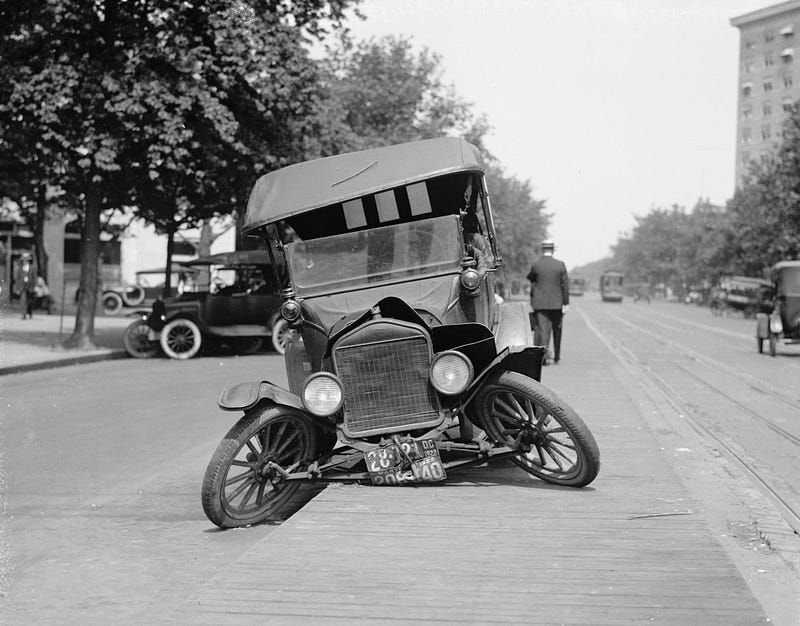The Future of Interesting Cars
For context; I’m a lifelong car enthusiast, club member, modifier, and owner of a Fiat 124 Coupé which will be my daily car when I can get…

For context; I’m a lifelong car enthusiast, club member, modifier, and owner of a Fiat 124 Coupé which will be my daily car when I can get it to work, and an Aston Martin DBS which is in several pieces. I theoretically own an old MG too, but appear to have lost it. I had hoped to continue in the same vein indefinitely, but my research into the future of my hobby, and the possibility of it becoming a vocation has meant that it was wise for me to have a very good look at the evidence as to how this will shake-out over the next twenty years. It’s not good news for combustion fans, and that’s a shame.
This is a good overview of why the world still loves historic cars which talks about the general public and speaks to their nostalgia. There has always been a pull toward simpler times, which is largely an illusion. We tend to forget about wars, rationing, disease, and popular entertainers. This article mentions many of the same points but adds an appreciation of engineering. It’s true to say that the engineering of an historic vehicle is more apparent than in modern cars, which hide everything under plastic and rely upon synthetic feedback systems.
There was a short period of introspection where I questioned whether I would be happy parroting the half-truths and non-sequiturs I hear every day in the car world. I decided that I would not be able to do that, and I would like to explain the reasons why.
In the UK at present, there are 338,697 cars registered as historic according to this study. Almost all of these are petrol-powered and we will crush all but a handful in the next 10–15 years.
Using the figures above; 338,697 historic cars, of which 41,217 are on Statutory Off-Road Notices. That leaves 297,480 cars between 67,596,281 people; 1 car for every 227 people. If we assume that the First World has a similar distribution across its population centres we have;
USA 341.485909m people, 1.5m cars
Canada 38.781291m people, 0.17m cars
EU 448.4m people, 1.975m cars
We could easily crush 5 million cars, which have survived the usual replacement cycle, and are adored, because they no longer fit into the world. That’s a lot of tears and embodied energy.

We have Greta Thunberg to thank because she alerted the world’s youth to the fact that we, and the generations before ours have not acted in a way that will enable the young people of today to live as we have done. Greta has been criticised for this, bitterly insulted, and repeatedly told she was wrong by politicians and vested interests. Well, I can tell you now that she was wrong; it’s dramatically worse than she thought it was when she decided upon her School Strike for The Environment. I won’t make environmental arguments here, but it is clear that we have big problems and while some will still argue, climate science is settled.
All cars are an ecological nightmare; even the most advanced electric car. At present, we have a special dispensation to drive historic cars because they are considered only a minor ecological nightmare. The problem we have is that while they have long since had the energy used in their construction discounted in fiscal terms, their fuel, oil and many treatments for their ageing shells are an ongoing problem.
There are two distinct problems caused by combustion cars; carbon emission and pollution, of which the latter includes particulates and nitrogen concentration. While there are others I will concentrate on these two because their properties encapsulate the two separate technological and political issues the industry will face.
Dealing first with nitrogen, or specifically NOx, we find that this is naturally occurring, but dangerous in high concentrations. Our special dispensation to drive any internal combustion vehicle inside a city will not last long in the light of evidence such as that. Put simply; NOx concentration is heavily implicated in the deaths of children. I doubt we’ll be driving anything that burns any sort of fuel into town in ten years.
Then we have the big one, if increased child mortality is not enough: No discussion on environmental matters is complete without the word carbon. We’ve built massive industries out of the principle of removing carbon from the ground and throwing it into the air. As atmospheric carbon increased, so did global average temperatures; global warming. If we stop mining and re-use the carbon in the air we can approach the gilded Net Zero. The simplest solution is not to burn anything; although carbon is emitted by concrete production and a few other industrial processes. I won’t be presenting evidence of anthropogenic global warming. If you feel you need to be further convinced of that you’re unlikely to understand this article.
While there are two distinct problems, there are also three possible solutions if we are to continue domestic private transport; hydrogen, synthetic fuels, and battery electric. Hydrogen is the most common element in the universe, Synthetic fuels use carbon and hydrogen to make an analogue for existing fossil fuels, and batteries use mineral/chemical cells to produce electricity which powers an electric motor. The first two are closely linked.
Hydrogen can be used in three ways. Firstly we can burn hydrogen in existing engines with relatively little modification. One problem with this is that the hydrogen/air combination is low in energy density, meaning that you either accept less power or higher fuel volume. Aston Martin ran a hydrogen-burning Rapide in the Nurburgring 2 race a few years ago and it had tanks inside the passenger compartment to be able to compete with petrol-powered cars. It’s not a practical proposition and its main champion, BMW, has given up on burning it. Another problem is that it creates a lot of nitrogen at the tailpipe. The oxygen and hydrogen create water, leaving nitrogen to pass into the atmosphere.
In this Cap Gemini report they state that if you adapt the engine with forced induction it can reach 40% efficiency, which is equivalent to a racing engine, although as the Aston Martin story above makes clear, such large volumes of fuel would be difficult to design around. This could be great for planes and ships, not so good for a car when originality is an issue but it is a possible solution for short-distance running, although synthetic fuels will probably tread on its sandwiches shortly.
The second use of hydrogen is to generate electricity using what is known as a fuel cell. Fuel cells behave like batteries which are ‘charged’ by pumping compressed hydrogen into them. Toyota has invested a huge amount of money into hydrogen fuel cells and has wasted every penny. Hydrogen fuel cell cars are electric cars with an unnecessarily complicated battery. The fuel cell does not save weight, or give an increase in range over a battery. Its sole benefit is that it can be refuelled more quickly than a battery can be recharged; an advantage that is not holding up well against the progress made by battery technology.
It takes a lot of energy to create hydrogen, and it’s a complex topic because we grade hydrogen according to its manufacture and provenance. At present hydrogen is made from fossil fuels, negating the point entirely. It is possible to make hydrogen from water, or even air, but it costs in energy. This is an excellent overview from the point of legislators making decisions
Forbes, for balance, discusses the more likely scenario where new technology fuels gradually replace mined fuel. I will return to synthetic fuels later, but the evidence presented in that article is useful here too. This piece discusses energy loss in production and this discusses land use when using biomass to produce fuels.
As you can see, it’s a complex issue, but it is something we need to know about because it’s very likely that we will use hydrogen in the aviation and shipping industries, possibly even road-going lorries.
The third option in hydrogen usage is to create synthetic fuels from hydrogen and many sources of carbon and thus make the fuel carbon-neutral if you are careful how you generate the energy required. It does bring the rather glorious idea to mind that we could capture the excess carbon in the air, and use it to make a carbon-neutral fuel. Excellent; job done. However, there is a problem. It takes an enormous amount of energy to create synthetic fuel. Seeing as synthetic fuels are the most likely saviour of the classic car I will reuse this research comparing its efficiency against the young pretender; the battery electric vehicle.
In addition to being dramatically more efficient than any other propelled vehicle, battery electric vehicles are very much more simple than internal combustion cars, and are simple to build from an existing vehicle. They require power from mineral/chemical batteries, usually Lithium Ion, and most recently the specific LFP variety of that cell. There are many steps in the construction of a battery electric car, and I’ll describe them briefly with the benefits and problems:
Almost all of the battery cell ingredients are mined, as is the case in all aspects of car production. There has been some controversy with cobalt, which is a bit nasty, but the industry is halfway through removing it entirely from the cells used in electric cars. Lithium too has to be mined at present and that’s never good. We must be clear to make a distinction in the processes of building the different types of cars. Specifically, we must distinguish between the minerals used in the construction of the car and those used to power it. As an example, the lithium in the battery of a car is not consumed, it’s part of the construction of the vehicle and remains intact until the day it is extracted during the recycling process and used to build a new battery cell. The minerals mined to make fuels are destroyed by combustion and the elements remaining are pumped into the atmosphere. This discussion has many interesting links and sub-topics and is presented as-is.
The construction of a battery electric car is very much simpler than building a combustion car. Many of the same processes are required in constructing the shell and interior, so they can be built in many of the same factories. Oddly there are fewer electronic components in an electric car; the battery needs a management system to keep it running at maximum efficiency, and a motor controller which uses capacitors to convert DC power from the battery to AC for the motor. Soon, this could all be DC with a considerable efficiency gain. DC motors are currently a pain.
In use, no minerals–mined or recovered–are consumed by an electric car. When its time has come it can be returned to its mineral components and made into another car. We’re close to such advances as solid-state and sodium batteries. Sodium batteries are with us now and don’t use lithium. Their energy density will probably always be too low for use in small personal transport vehicles, but they are ideal for domestic and industrial use. They are safe, efficient and very cheap. Solid-state batteries are a nascent technology which creates an inert battery which could form the structure of the car. They will be energy-dense and never catch fire. Fire has been a topic recently, so I’ll cover it.
In this article, the author looks at how likely it is that electric vehicles are causing problems and comes to the conclusion that they are not. This article talks about general safety and the differences between battery chemistries and finds in favour of LFP cells. Many early electric cars and most cheap scooters use the NMC cell type, which not only uses cobalt but is prone to runaway overheating. The small battery fires that have made the news have been NMC, and that technology is now a dead-end.
So battery electric cars win the battle of efficiency, ecology, and plain old common sense. E-fuel is a transition phase which will help us run larger vehicles, and enjoy the last days of internal combustion on the road. We can use hydrogen in ships, and there have been some excellent hybrid solutions dreamt up for planes. On the road, we will have battery electric vehicles. Motorsports and historic vehicle runs will happen for decades as they will have a marginal effect on the environment, and the most special vehicles can continue to run on what is a very good synthetic analogue of fossil fuels. The problem is that the number of truly special vehicles is tiny, and the rest of the world will not be able to afford to run an historic combustion vehicle.
We must convert our much-loved cars to battery electric.
In my opinion, and there can be no facts here because it has yet to happen, governments will tax synthetic fuels heavily for the simple reason that the energy required to turn the wheels of a car will need at least five times as much land use for solar panels or wind turbines. Please note that the area of land required to power the planet is not significant. This is a good explanation and has a link to the original research.
I’ve made it clear a couple of times that the focus of this article is the likely response by legislators to external pressure from science. This is no longer a matter of opinion, activism, or disagreement. It’s settled and the course is set. One only has to look at how climate change is changing the political landscape to understand why politicians are reacting decisively, in most cases. Energy and water security are big worries and are closely related to fears over migration. While at present the issue of migratory workers is feeling a rise in populism, I can’t imagine what will happen when parts of the world run out of water and begin an exodus.
Think about the possibility of a paradise; solving energy and water scarcity by using solar desalination plants to provide clean water, sodium for batteries, and carbon and hydrogen for vehicles which need it. There is political will behind solving these problems by pushing quickly towards a new transport infrastructure, and that can be seen in the steps that politicians are taking to stop us from repairing old cars. Many countries have employed ‘scrappage’ or ‘cash for clunkers’ schemes because they want old cars off the roads. Historic vehicle schemes are designed to placate economically active voters and I’m certain they will continue for a while but they will not continue forever, and they will likely soon exclude urban use because of the NOx issues I raised earlier.
In addition to the EU repair laws mentioned above, there are many challenges in other parts of the world. In my native UKoGBaNI, our vehicle licensing authority operates a points scheme to decide whether your vehicle is actually an historic vehicle. As you can see from this, a car with no other modifications will score 9 points out of twelve, meaning it can keep its status and registration number. The problem is that if it scores 7 because its brakes, suspension, or steering are inadequate for current traffic conditions it will no longer be an historic car and will use a registration plate beginning with the letter Q. I know of a conversion on a classic Mini, where the UK licensing authority forced the owner to scrap his car because he enlarged a hole to pass a cable through it.
If we wish to convert historic cars to battery electric power there will be technological bumps in the road caused by antiquated engineering in the original cars; front cross-members limit battery size, live axles located with semi-elliptical springs wind-up and break under relentless torque, front-wheel-drive requires the battery, drive unit, and transaxle be located in the same place. The worst problem is that their structures are not always as strong as we would hope and have deteriorated since manufacture. They were only supposed to last ten years, and don’t get me started on their safety features.
In conclusion: This is the clash of the Titans; 150 years of sonorous, disruptive, fire-wrangling automotive history hits 250 years of environmental damage, and we get to sort it out. Aren’t we lucky! We have to accept that the old ways are over, and while we’re allowed to rev our twin cams today because all cars make noise, will we still be allowed to do that when most cars are as silent as an angel’s fart?
I know that this is not what car enthusiasts wish to hear. I’m a car enthusiast, and I would have been delighted to putter around in my Fiat until I’m no longer required, but it won’t happen. What will happen is that I’ll swish around in a stylish vehicle while paying little tax, and at very little cost per mile until I’m no longer required. This is sensible. Enthusiasts worry that electric cars are inherently sensible, not exciting, and all I can say in return is that I’m trying my best.










